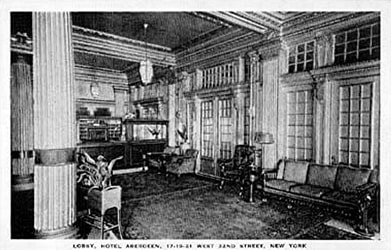 By M.P. Pellicer | Stranger Than Fiction Stories On October 24, 1905 Mary Jane Caley was staying in Suite 72 at The Aberdeen Hotel; the same one she had rented several times in the past. That day she had already bought her ticket to return by train to her hometown of Cleveland, Ohio. Then for some unfathomable reason she shot herself in the temple. Why would a wealthy, 21-year-old woman do this?  Aberdeen Hotel lobby c.1904-1905 Aberdeen Hotel lobby c.1904-1905 Manhattan, New York, 1901 Penn Station was under construction, and Macy's had opened on 34th St. Around the corner from Tiffany, B. Altman and the Waldorf-Astoria Hotel, plans were underway to build a new Beaux-Arts hotel. A style called apartment hotels, which were the latest thing for out-of-towners who needed a pied-a-terre, without the need to hire servants or worry about maintenance. Residents dined in a communal dining room or restaurant, and hotel staff catered to their needs. In September, 1904 The Aberdeen, a 12-story brick and limestone structure opened its doors. Like all places that welcome strangers who bring their love stories, hopes and woes, scandal would soon visit the new hotel. It came in the form of Mary Jane Caley. She was the daughter of Thomas and Mary Caley. However by the time Mary paid her visit to the Aberdeen, her mother was married to George Walker and the prosperous family lived in Ohio. The body was found by Mrs. Allen who lived in the suite next to Mary. She would accompany Mary on trips to the Ladies’ Mile shopping, which was close by. The dead woman was fully dressed, and it seemed she had stood in front of the mirror when she was shot. The revolver lay beside her on the floor. Two cartridges had been freshly discharged, but only one bullet could be found. On a table in her room was a linked gold purse studded with diamond and rubies, and the contents included $133. There was a number of rings; a heart-shaped pin set with diamonds, a large pin set with diamonds, and two bar pins studded with diamonds. She had bought several furs, which were already packed. Most of her toiletries were monogrammed with her initials. There was also a package of letters tied with a white ribbon. There was one envelope addressed: "For Lillian, care of Mrs. G. Allen. Give to Jack; don't mention names." Inside the envelope was a letter which read: "Tired, tired. Forgive me, darling sister. Love me, May." The Lillian referred to in the suicide note was believed to be Lillian Castle (aka Lillian Landes) of Tarrytown. Mrs. Allen had met her through Mary who referred to her as "Lillian, my half sister."  Group at Oyster Bay, Long Island Yacht Club c.1905 Group at Oyster Bay, Long Island Yacht Club c.1905 Even though Mary Caley's death appeared to be strictly a suicide, there was enough questions asked that inevitably her dirty laundry was aired. Especially when her mother said she was sure there was foul play involved. First, there was some mystery as to how long Mary had been staying at the Aberdeen when she was killed. The authorities were trying to retrace her whereabouts, and it was determined that in the spring of 1905, she spent two months at the Hamilton Hotel at West 45th St. Supposedly she had returned to Cleveland afterward. However no one could verify how long she had been staying at the Aberdeen this last time. The management said she had been there no more than 4 days, but at a bureau for nurses in West 21st St, they stated that a trained nurse had been to her room at the Aberdeen on September 16. In between her active social life, Mary visited her wealthy uncle Nelson who lived on 32nd Street in New York, and she was a regular attendant at John D. Rockefeller's church. She was no stranger to the city. To add to the gossip, it seemed that Mary Jane Caley led a sensational life before her death. Since she was 16, she traveled from coast to coast, associating with prominent men of the country, and always had jewels and plenty of money. In New York she was well acquainted with important men in baseball and sporting circles, where Ralph Pitzer ran a saloon which might explained how she eventually became his wife. During the Pan-American Exposition held in Buffalo in 1901, a reputed marriage occurred between her and Ralph Pitzer. According to Pitzer, it was a result of a bet in which the wife of a prominent Boston rubber man, and the sister of a well-known actress who were members of the party, propositioned that Pitzer marry Miss Caley. He said he refused, and at the instigation of other members of the party a supposed Justice of the Peace was sent for to perform the ceremony. Pitzer said he never lived with her, and even though they stayed at the Iroquois Hotel for several days, they occupied separate rooms. He said he led a roving life traveling from New York to San Francisco. He denied seeing her again after he left Buffalo, and she made no claim against his name. However this story later proved to be false since Mary had visited Youngstown, Ohio twice and both times met with him. Whether they were truly married or not, they mostly led separate wives. Four years later, there was another man in Mary Caley's life. Among her papers there was a letter addressed to Mary from a man who used the stationery of the New York Athletic Club, and signed with the name "Jack". Mrs. Allen said that Jack had introduced himself to Mary Caley one day as they were in the elevator. The love letter was two or three months old. Jack wrote that his yacht was anchored at the foot of 34th Street on the East River, and that he would soon set off for Halifax. He would not be back until September 5. He apologized for being away so soon. He wrote: "The widows and things you speak of don't exist for me. I am the only single man on board, but the others are grass widowers temporarily. I love you, Pet, more than anything else in the world." Three weeks before her death, Mary Caley had moved into a boarding house owned by Mrs. E. S. Waller at 245 Sibley Street, Cleveland. She planned to train as a nurse at the Lakeside Hospital school. Mrs. Waller said that on October 12, a well-dressed man who registered at The Colonial Hotel in the city, visited with Mary Caley at her home. He drove a red automobile and was tall and broad shouldered. The two were together all evening, than he went away. According to Mrs. Waller, the young woman departed the next day. The man was supposed to be a traveling salesman from New York. Mrs. Waller and her two daughters met Mary Caley at a summer resort at North Madison the summer of 1905. Mrs. Waller said "She always had plenty of money. I can only think that she was jilted by the man, who called on her ten days ago. Who the man was I do not know. He was her only caller in the three weeks that she was at my house." One of the hotel clerks at the Aberdeen said that on one occasion he asked one of Mary Caley's male visitors for his full name in order to announce him, and he said "Mr. McIlvaine wants to see Miss Caley." It was reported that he took her riding nearly every day. Was Jack McIlvaine his real name? A check with the New York Athletic Club found no member with that name. The coroner disclosed that a short time before her suicide, Mary Caley had received a message which had been telephoned to the hotel. It stated that the sender, a man, was sorry but he couldn't see her. The question remained if this is what drove to take her life.  Portrait of a young woman c.1905 Portrait of a young woman c.1905 Mrs. Clark believed her daughter was a victim of foul play. A month after Mary's death she engaged Arthur Sharp a real estate dealer to go and reopen the case. He was tasked to obtain the letter her daughter wrote to "Jack", which somehow had mysteriously disappeared. She said that her daughter had more money, than what was found at the scene of her death. She said, "I can never believe that my daughter took her own life. She had made all preparations to come here (to Ohio). Someone murdered her, and I shall not stop until he is punished." She said that Mary expected to marry Jack as soon as she could get a divorce from Frank Pitzer. The separation had taken place because Mary claimed her husband had another favorite, and she was afraid of the woman for who Pitzer showed the most love. She said this woman had threatened to kill her. Had Mary lied to her mother about the validity of her marriage? Could that explain why she never took the surname of Pitzer? Nothing further was published about Mary Jane Caley, not even details about her burial. What came of Arthur Sharp's investigation also remained a mystery. Was it because he didn't find anything, or perhaps what he found was so damaging it was preferable to leave Mary's cause of death as a suicide? Was she killed because of an inconvenient love affair, or was robbery the reason? In March 1906, an inventory was made of Mary Caley's estate. It was appraised at $814.45, made up of money, diamonds, jewelry and clothing. This is equivalent to $26,000 present day. In 1912, The Aberdeen was sold, and the large suites were broken down into smaller apartments for the use of transient guests. Suite 72 where Mary Caley died standing in front of a mirror was no more.
0 Comments
Your comment will be posted after it is approved.
Leave a Reply. |
Stranger Than Fiction StoriesM.P. PellicerAuthor, Narrator and Producer Archives
July 2024
Categories
All
|
Stories of the Supernatural
- Stories of the Supernatural
- Miami Ghost Chronicles
- M.P. Pellicer | Author
- Stranger Than Fiction Stories
- Eerie News
- Supernatural Storytime
-
Astrology Today
- Tarot
- Horoscope
- Zodiac
-
Haunted Places
- Animal Hauntings
- Belleview Biltmore Hotel
- Bobby Mackey's Honky Tonk
- Brookdale Lodge
- Chacachacare Island
- Coral Castle
- Drayton Hall Plantation
- Jonathan Dickinson State Park
- Kreischer Mansion
- Miami Biltmore Hotel
- Miami Forgotten Properties
- Myrtles Plantation
- Pinewood Cemetery
- Rolling Hills Asylum
- St. Ann's Retreat
- Stranahan Cromartie House
- The Devil Tree
- Trans-Allegheny Lunatic Asylum
- West Virginia Penitentiary
- Paranormal Podcasts
"When misguided public opinion honors what is despicable and despises what is honorable, punishes virtue and rewards vice, encourages what is harmful and discourages what is useful, applauds falsehood and smothers truth under indifference or insult, a nation turns its back on progress and can be restored only by the terrible lessons of catastrophe."
- Frederic Bastiat
- Frederic Bastiat

Copyright © 2009-2024 Eleventh Hour LLC. All Rights Reserved ®
DISCLAIMER
DISCLAIMER
 RSS Feed
RSS Feed
















